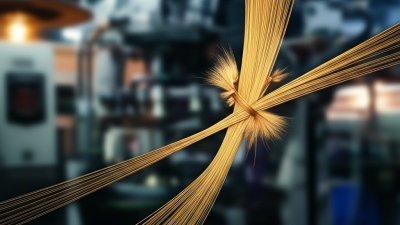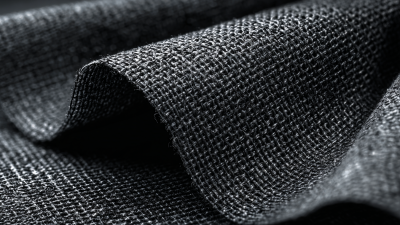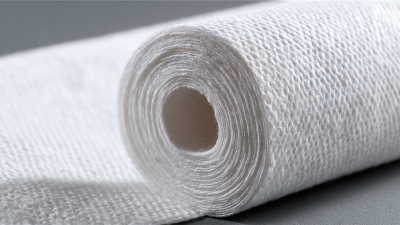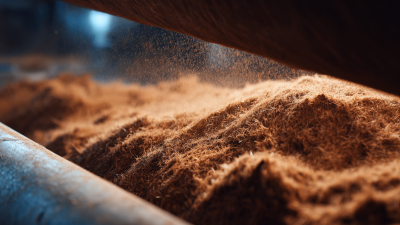Challenges Encountered with Pbo Fiber Ribbon in Modern Manufacturing
Table of Contents
- Understanding Pbo Fiber Ribbon: Properties and Applications in Manufacturing
- Common Issues with Pbo Fiber Ribbon: A Deep Dive into Performance Challenges
- Impact of Temperature Variations on Pbo Fiber Ribbon Durability
- Strategies for Mitigating Manufacturing Disruptions Caused by Pbo Fiber Ribbon
- Emerging Solutions: Innovations to Enhance Pbo Fiber Ribbon Performance
- Industry Insights: Data Trends on Pbo Fiber Ribbon Usage in Modern Manufacturing
- FAQS
- Conclusion
- Related Posts
In the rapidly evolving landscape of modern manufacturing, the integration of advanced materials such as Pbo Fiber Ribbon is increasingly vital for optimizing product performance and durability. According to recent industry reports, the global market for high-performance fibers is projected to reach $17.1 billion by 2027, driven by the growing demand for lightweight and resilient materials in various applications, including aerospace and automotive sectors.
 However, manufacturers face significant challenges when incorporating Pbo Fiber Ribbon into their processes, particularly concerning its thermal stability and compatibility with other materials. As an advanced manufacturer, Shijiazhuang Shielday Technology Co., Ltd. recognizes the importance of overcoming these obstacles to leverage the exceptional properties of this innovative fiber. By providing specialized EMI shielding textiles and conductive wires tailored to the needs of today's market, Shielday Technology is poised to address these challenges while pushing the boundaries of what's possible in modern manufacturing.
However, manufacturers face significant challenges when incorporating Pbo Fiber Ribbon into their processes, particularly concerning its thermal stability and compatibility with other materials. As an advanced manufacturer, Shijiazhuang Shielday Technology Co., Ltd. recognizes the importance of overcoming these obstacles to leverage the exceptional properties of this innovative fiber. By providing specialized EMI shielding textiles and conductive wires tailored to the needs of today's market, Shielday Technology is poised to address these challenges while pushing the boundaries of what's possible in modern manufacturing.
Understanding Pbo Fiber Ribbon: Properties and Applications in Manufacturing
Poly(p-phenylene-2,6-benzobisoxazole) (PBO) fiber ribbon has emerged as a vital component in modern manufacturing due to its unique properties, including exceptional thermal stability, high tensile strength, and lightweight characteristics. These attributes make PBO fibers suitable for high-performance applications across diverse sectors such as aerospace, automotive, and electronics. Recent advancements highlight the development of high-strength super-hydrophobic double-layered PBO nanofiber-polytetrafluoroethylene nanocomposite paper, which is designed for wave-transparent applications. This innovative material demonstrates improved performance due to its enhanced interaction between PBO nanofibers, addressing critical challenges faced in manufacturing.
The growing demand for high-performance materials has necessitated a deeper understanding of the properties and applications of PBO fiber ribbons. Industry reports indicate that the global demand for high-temperature resistant fibers is projected to grow at a CAGR of over 8% in the next five years. Key challenges include scaling up production while maintaining the desired mechanical properties and processing methods required for practical applications.
Research is ongoing to improve the compatibility and adhesion between fibers and matrices, which is essential for enhancing the overall performance of PBO-based composites in demanding environments. These developments underline the importance of innovation and research in overcoming the challenges posed by PBO fiber ribbons in modern manufacturing.
Common Issues with Pbo Fiber Ribbon: A Deep Dive into Performance Challenges
In modern manufacturing, PBO (Polybenzoxazole) fiber ribbons are increasingly favored for their high-performance attributes, but various challenges can hinder their effectiveness. One prominent issue is their susceptibility to environmental factors, particularly high temperatures. While PBO fibers can withstand extreme conditions better than many alternatives, prolonged exposure to excessive heat can degrade their structural integrity, leading to reduced performance and lifespan.
Another significant concern is the ribbon's compatibility with other materials used in production. In composite applications, the adhesive properties of PBO fiber may vary depending on the substrate, which can result in poor bonding and reduced overall strength of the final product. Moreover, PBO fibers can be more expensive than traditional fibers, adding to manufacturing costs and requiring careful consideration during the design phase to ensure that the benefits of their use outweigh these additional expenses. Addressing these challenges is essential for manufacturers looking to harness the full potential of PBO fiber ribbons in their processes.
Impact of Temperature Variations on Pbo Fiber Ribbon Durability
Temperature variations can significantly impact the durability of PBO (Polybenzobisoxazole) fiber ribbons, which are increasingly utilized in modern manufacturing due to their exceptional strength and thermal stability. However, the resilience of these ribbons to extreme temperature fluctuations raises concerns among manufacturers. The structural integrity of PBO fiber can be compromised if exposed to prolonged heat or rapid cooling, leading to potential failures in applications that demand high reliability.
Moreover, the performance of PBO fiber ribbons is not solely dependent on temperature extremes but also on the rate of temperature change. Rapid thermal cycling can induce stress within the fibers, causing micro-cracks that accumulate over time. This wear can result in reduced load-bearing capacity and decreased lifespan, undermining the material's advantages. Manufacturers must therefore consider implementing controlled environments and advanced monitoring systems to mitigate these temperature-related challenges, ensuring the longevity and effectiveness of PBO fiber ribbons in their operations.
Challenges Encountered with Pbo Fiber Ribbon in Modern Manufacturing - Impact of Temperature Variations on Pbo Fiber Ribbon Durability
This bar chart illustrates the durability of Pbo fiber ribbon at various temperature levels, highlighting how extreme temperatures affect its performance. The peak durability is observed at room temperature, while extreme heat and cold lead to a significant decrease in durability.
Strategies for Mitigating Manufacturing Disruptions Caused by Pbo Fiber Ribbon
In modern manufacturing, the integration of Pbo fiber ribbons presents unique challenges that require strategic mitigation to minimize disruptions. These ribbons, while beneficial for lightweight and high-performance applications, can lead to complications in production processes. Factors such as material handling difficulties and varying quality standards often hinder efficiency, impacting not only output but also employee morale. Companies are increasingly recognizing that addressing these issues is vital for sustaining production quality and meeting market demands.
To counteract the disruptions caused by Pbo fiber ribbons, manufacturers must invest in upskilling their workforce. By enhancing employee capabilities, businesses can improve adaptation to new materials and technologies, fostering a more agile production environment. Implementing training programs focused on best practices for handling Pbo fibers can equip workers with the knowledge necessary to mitigate potential issues before they escalate into larger setbacks. This proactive approach not only boosts overall productivity but also contributes to higher job satisfaction and retention rates, creating a resilient manufacturing unit poised to thrive amidst the complexities of modern production landscapes.
Emerging Solutions: Innovations to Enhance Pbo Fiber Ribbon Performance
The performance limitations of PBO fiber ribbons in modern manufacturing are increasingly being addressed through innovative solutions aimed at enhancing their capabilities. With the growing demand for high-performance materials in various industries, including aerospace, electronics, and automotive, researchers are focusing on improving the mechanical properties and thermal stability of PBO fibers. According to recent industry reports, the global market for advanced fiber composites is projected to reach over $40 billion by 2026, highlighting the urgent need for innovations that optimize fiber performance.
Emerging technologies, such as AI-driven manufacturing processes, are paving the way for enhanced PBO fiber ribbon performance. Automated systems are being developed to monitor and control the production environment, ensuring consistent quality and performance of the fibers. This shift towards smart manufacturing not only improves efficiency but also allows for real-time adjustments to production parameters, minimizing defects and waste. Recent advancements in material science have also led to the exploration of hybrid fiber structures that combine PBO with other materials, resulting in improved characteristics that meet the rigorous demands of modern applications.
Industry Insights: Data Trends on Pbo Fiber Ribbon Usage in Modern Manufacturing
The utilization of PBO (polybenzoxazole) fiber ribbon is gaining traction in modern manufacturing due to its exceptional strength and heat resistance properties. Recent data trends reveal that industries are increasingly adopting this advanced material for applications in aerospace, automotive, and high-performance textiles. With a notable increase in investment towards research and development, manufacturers are keen to harness the advantages of PBO fiber ribbon, which can withstand extreme conditions while maintaining structural integrity.
However, the integration of PBO fiber ribbon into existing manufacturing processes comes with its own set of challenges. Data indicates that many manufacturers face difficulties in sourcing the high-quality raw materials required for production, and the specialized machinery needed to handle PBO fibers can be a significant barrier to entry. Additionally, the knowledge gap in understanding the best practices for incorporating PBO ribbons into their products often leads to inefficiencies. As industry stakeholders strive to overcome these hurdles, they are focused on developing training programs and collaborating with suppliers to enhance the overall adoption and efficacy of PBO fiber ribbon in modern manufacturing settings.
Challenges Encountered with Pbo Fiber Ribbon in Modern Manufacturing - Industry Insights
| Challenge | Percentage of Manufacturers Affected | Common Solutions | Future Trends |
|---|---|---|---|
| Cost of Raw Materials | 68% | Bulk Purchasing, Supplier Negotiation | Increased Recycling Efforts |
| Production Speed | 54% | Process Optimization, Automation | Dynamic Manufacturing Technologies |
| Quality Control | 46% | Enhanced Testing Protocols, Training | AI and Machine Learning for Quality Assurance |
| Supply Chain Disruptions | 63% | Diversified Suppliers, Inventory Management | Digital Supply Chain Solutions |
| Regulatory Compliance | 50% | Consultations, Regular Audits | Adaptive Compliance Technologies |
FAQS
: PBO fiber ribbon, or poly(p-phenylene-2,6-benzobisoxazole) fiber ribbon, is known for its exceptional thermal stability, high tensile strength, and lightweight characteristics, making it suitable for high-performance applications across various sectors.
PBO fiber ribbons are utilized in several industries, including aerospace, automotive, and electronics, due to their high-performance properties.
Recent advancements include the development of high-strength super-hydrophobic double-layered PBO nanofiber-polytetrafluoroethylene nanocomposite paper, which is designed for wave-transparent applications and offers improved performance.
The global demand for high-temperature resistant fibers is projected to grow at a compound annual growth rate (CAGR) of over 8% in the next five years.
Key challenges include scaling up production while maintaining desired mechanical properties, ensuring compatibility and adhesion between fibers and matrices, and addressing temperature-related durability concerns.
Temperature variations can significantly impact the durability of PBO fiber ribbons, with extreme temperature fluctuations and thermal cycling potentially compromising their structural integrity and leading to micro-cracks.
Manufacturers should implement controlled environments and advanced monitoring systems to mitigate temperature-related challenges and ensure the longevity of PBO fiber ribbons in their operations.
Rapid thermal cycling can induce stress within the PBO fibers, causing micro-cracks that accumulate over time, which can reduce load-bearing capacity and lifespan.
Ongoing research is crucial to improve the performance of PBO-based composites, enhance compatibility and adhesion, and overcome challenges faced in modern manufacturing applications.
Innovation and research are key to developing new solutions to enhance PBO fiber performance and solve critical challenges in manufacturing, ensuring their effectiveness in demanding environments.
Conclusion
Pbo Fiber Ribbon plays a crucial role in modern manufacturing, thanks to its unique properties that enhance performance in various applications. However, manufacturers often face challenges related to its durability and performance, particularly when subjected to temperature variations. Understanding these common issues is vital for industries that rely on Pbo Fiber Ribbon, as they can lead to significant disruptions in production.
To address these challenges, manufacturers can implement strategic mitigation strategies and explore emerging innovations aimed at enhancing the performance of Pbo Fiber Ribbon. As the industry evolves, staying informed on data trends regarding its usage can also provide valuable insights for manufacturers looking to optimize their processes. At Shijiazhuang Shielday Technology Co., Ltd., we are committed to delivering advanced solutions, including high-performance textiles and conductive wires, to meet the growing demands of modern manufacturing sectors that utilize Pbo Fiber Ribbon.
Related Posts
-

10 Industry Standards for Best Fire Resistant Fabric and 7 Reasons to Choose Them
-

Exceptional Tinned Tinsel Wire Manufacturing in China for Global Buyers
-

Mastering Ef Nonwoven Fabric Techniques for Innovative Applications
-

Unlocking the Advantages of Pbo Short Fiber in Modern Manufacturing Processes
-

How to Navigate Import and Export Certifications for Best Conductive Tape
-

Unlocking the Advantages of Steel Microwire in Modern Applications

